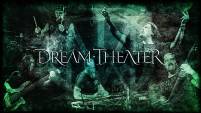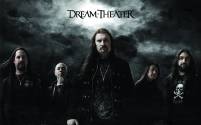Dream Theater is an American Progressive metal band formed in 1985 under the name Majesty by John Petrucci, John Myung, and Mike Portnoy while they attended Berklee College of Music in Massachusetts. They subsequently dropped out of their studies to concentrate further on the band that would ultimately become Dream Theater. Though a number of lineup changes followed, the three original members remained together along with James LaBrie and Jordan Rudess until September 8, 2010, when Mike Portnoy left the band. In October 2010, the band held auditions for a drummer to replace Mike.
Mike Mangini was announced as the new permanent drummer on April 29, 2011.
The band is well known for the technical proficiency of its instrumentalists, who have won many awards from music instruction magazines. Guitarist John Petrucci has been named as the third player on the G3 tour six times, more than any invited players. In 2009 he was named the No. 2 best metal guitarist by Joel McIver in his book The 100 Greatest Metal Guitarists. He was also named as one of the "Top 10 Fastest Shredders of All Time" by GuitarOne magazine. Jordan Rudess is considered to be one of the greatest keyboard players of all time by many publications like MusicRadar. Former drummer Mike Portnoy has won 26 awards from Modern Drummer magazine and is also the second youngest person (at the age of 37) to be inducted into the Rock Drummer Hall of Fame. His replacement Mike Mangini has also previously set 5 WFD records. John Myung was voted the greatest bassist of all time in a poll conducted by MusicRadar in August through September 2010. The band was inducted into the Long Island Music Hall of Fame in 2010.
The band's highest-selling album is the gold-selling Images and Words (1992), which reached No. 61 on the Billboard 200 chart. Both the 1994 release Awake and their 2002 release Six Degrees of Inner Turbulence also entered the charts at No. 32 and No. 46 respectively and received mostly positive reviews. Metropolis Pt. 2: Scenes from a Memory was ranked number 95 on the October 2006 issue of Guitar World magazine's list of The greatest 100 guitar albums of all time. It is ranked as the 15th Greatest Concept Album (as of March 2003) by Classic Rock Magazine and as the number one all-time progressive album by Rolling Stone (as of July 2012). Six Degrees of Inner Turbulence also led to Dream Theater becoming the initial band reviewed in the music section of Entertainment Weekly during its opening week of release, despite the magazine generally preferring more mainstream music.
The band's eleventh studio album, A Dramatic Turn of Events, was released on September 13, 2011. On November 30, 2011, the album's lead single, "On the Backs of Angels", was nominated for a Grammy Award in the "Best Hard Rock/Metal Performance" category, marking the band's first ever Grammy nomination. Dream Theater's self-titled twelfth studio album was released on September 23, 2013 and earned their second Grammy Award nomination, this time for “Best Metal Performance”, for the album's first single, "The Enemy Inside".
On April 9, 2013, Images and Words won Loudwire's fan voted March Metal Madness for world's best metal album beating albums by Dio, AC/DC, Judas Priest, Megadeth and Metallica. As of 2011, Dream Theater has sold over 12 million records worldwide.
Early years (1985–1990)
Formation
Dream Theater was formed in Massachusetts in 1985 when guitarist John Petrucci, bassist John Myung, and drummer Mike Portnoy decided to form a band while attending the Berklee College of Music. The trio started by covering Rush and Iron Maiden songs in the rehearsal rooms at Berklee.
Myung, Petrucci, and Portnoy joined together on the name Majesty for their newly formed group. According to the The Score So Far... documentary, they were waiting in line for tickets to a Rush concert at the Berklee Performance Center while listening to the band on a boom box. Portnoy commented that the ending of the song "Bastille Day" (from the album Caress of Steel) sounded "majestic". It was then decided that Majesty would be the band's name.
The trio then set out to fill the remaining positions in the group. John Petrucci asked his high school band-mate Kevin Moore to play the keyboard. After he accepted the position, another friend from home, Chris Collins, was recruited as lead vocalist after band members heard him sing a cover of "Queen of the Reich" by Queensrÿche. During this time, Portnoy, Petrucci, and Myung's hectic schedules forced them to abandon their studies to concentrate on their music, as they did not feel they could learn more in college. Moore also left his college, SUNY Fredonia, to concentrate on the band.
The beginning months of 1986 were filled with various concert dates in and around the New York City area. During this time, the band recorded a collection of demos, titled The Majesty Demos. The initial run of 1,000 sold out within six months, and dubbed copies of the cassette became popular within the progressive metal scene. The Majesty Demos are still available in their original tape format today, despite being released officially on CD, through Mike Portnoy's YtseJam Records.
In November 1986, after a few months of writing and performing together, Chris Collins was fired. After a year of trying to find a replacement, Charlie Dominici, who was far older and more experienced than anyone else in the band, successfully auditioned for the group. With the stability that Dominici's appointment brought to Majesty, they began to increase the number of shows played in the New York City area, gaining a considerable amount of exposure.
Shortly after hiring Dominici, a Las Vegas group also named Majesty threatened legal action for intellectual property infringement related to the use of their name, so the band was forced to adopt a new moniker. Various possibilities were proposed and tested, among them Glasser, Magus, and M1, which were all rejected, though the band did go as Glasser for about a week, though fans reacted poorly to this decision. Eventually, Portnoy's father suggested the name Dream Theater, the name of a small theater in Monterey, California, and the name stuck.
When Dream and Day Unite (1988–1990)
With their new name and band stability, Dream Theater concentrated on writing more material while playing more concerts in New York and in neighboring states. This eventually attracted the attention of Mechanic Records, a division of MCA. Dream Theater signed their first record contract with Mechanic on June 23, 1988 and set out to record their debut album. The band recorded the album at Kajem Victory Studios in Gladwyne, Pennsylvania. Recording the basic tracks took about 10 days, and the entire album was completed in about 3 weeks.
When Dream and Day Unite was released in 1989 to far less fanfare than the band had anticipated. Mechanic ended up breaking the majority of the financial promises they had made to Dream Theater prior to signing their contract, so the band was restricted to playing around New York City. The promotional tour for the album consisted of just five concerts, all of which were relatively local. Their first show was at Sundance in Bay Shore, New York opening for the classic rock power trio Zebra.
After the fourth show, Charlie Dominici was let go because the band was starting to feel the limitations of his voice based upon the vocal style they wanted. The band was looking for a singer with a style more like Bruce Dickinson or Geoff Tate, and Dominici's stage presence was not what they wanted for a front man. Shortly after, however, the band Marillion asked Dream Theater to open for them at a gig at the Ritz in New York, so Dominici was given the opportunity to perform one last time. It would be another two years before Dream Theater had a replacement vocalist.
The addition of James LaBrie and Images and Words (1991–1993)
Following Dominici's departure, Dream Theater fought successfully to be released from their contract with Mechanic, and set about auditioning singers and writing material for their next album. In their search for a new singer, they auditioned over 200 people, among them former Fates Warning front man John Arch. John ultimately decided that his personal commitments were more important and he opted not to join the band. In mid-1990, at a gig in New York, Dream Theater introduced Steve Stone as their new singer. Stone had successfully recorded demos with Dream Theater, but he was fired following a single, ill-fated live performance. According to Mike Portnoy, Stone moved around the stage in a rather odd manner, seemingly doing a bad impression of Bruce Dickinson. Additionally, he shouted "Scream for me Long Beach!" several times throughout the show (Dickinson can be heard saying this on Iron Maiden's live album Live After Death), although they were actually performing in Bayshore. It was five months before Dream Theater played another show, this time all-instrumental (under the name YtseJam). Until 1991, the band remained focused in an attempt to hire another singer and writing additional music. It was during this period that they wrote the majority of what would become Images and Words (1992).
In January 1991, the band received a demo tape from Kevin James LaBrie, of Glam metal band Winter Rose. The band had received the tape just before they were about to commit to another singer. The band was so impressed by his demo that he was flown from Canada to New York for an audition. LaBrie jammed on three songs with the band, and was immediately hired to fill the vocalist position. Once recruited, LaBrie decided to drop his first name to avoid confusion with the other Kevin in the band. For the next few months, the band returned to playing live shows (still mostly around NYC), while working on vocal parts for the music written before acquiring LaBrie. Derek Shulman and Atco Records (now EastWest), a division of Elektra Records, signed Dream Theater to a seven album contract based on a three song demo (later made available as "The Atco Demos" through the Dream Theater fan club).
The first album to be recorded under their new record contract was Images and Words (1992). For promotion, the label released a CD Single and video clip for the song "Another Day", but neither made significant commercial impact. The song "Pull Me Under", however, managed to garner a high level of radio airplay without any organized promotion from the band or their label. In response, ATCO produced a video clip for "Pull Me Under", which saw heavy rotation on MTV. A third video clip was produced for "Take the Time", but it was not nearly as successful as "Pull Me Under".
The success of "Pull Me Under", combined with relentless touring throughout the U.S. and Japan, caused Images and Words to achieve gold record certification in the States and platinum status in Japan. A tour of Europe followed in 1993, which included a show at London's famed Marquee Club. The show was recorded and released as Live at the Marquee, Dream Theater's first official live album. Additionally, a video compilation of their Japanese concerts (mixed in with documentary-style footage of the off-stage portion of the tour) was released as Images and Words: Live in Tokyo.
Awake and Kevin Moore's departure (1994–1995)
Eager to work on fresh material, Dream Theater retreated to the studio in May 1994. Awake, Dream Theater's third studio album, was released on October 4, 1994 amidst a storm of fan controversy. Shortly before the album was mixed, Moore had announced to the rest of the band that he would be quitting Dream Theater to concentrate on his own musical interests, since he was no longer interested in touring or the style of music which Dream Theater performed. As a result, the band had to scramble to find a replacement keyboardist before a tour could be considered.
Former Yngwie Malmsteen/Dio keyboardist Jens Johansson, who would go on to become a member of Stratovarius, was among the biggest names to audition, but the band members were eager to fill the position with keyboardist Jordan Rudess. Mike Portnoy and John Petrucci had come across Jordan Rudess in Keyboard Magazine, where he was recognized as "best new talent" in the readers' poll. The two invited him to play a trial gig with the band at the Concrete Foundations Forum in Burbank, California. Although the show was a success, and Jordan Rudess was asked to fill the keyboardist position permanently, he opted to tour with The Dixie Dregs instead, since it granted him more personal latitude. Dream Theater hired fellow Berklee alumnus Derek Sherinian, who had previously toured and recorded with Alice Cooper and Kiss, to fill in for the Waking Up the World Tour. By the conclusion of the tour, the band decided to take Derek Sherinian on as Kevin Moore's full-time replacement.
Albums
Members
Bootlegs
Dream Theater have released a series of official bootlegs, demos and other rarities through YtseJam Records, headed by Portnoy.
Demos
The Majesty Demos (1985–1986)
When Dream and Day Unite Demos (1987–1989)
Images and Words Demos (/1989–1991)
Awake Demos (1994)
Falling Into Infinity Demos (1996–1997)
Train of Thought Instrumental Demos (2003)
Studio docu
The Making of Falling Into Infinity
The Making of Scenes From a Memory
Live albums
New York City – (1993) (CD)
Tokyo, Japan – (1995) (CD)
Old Bridge, New Jersey (1996) (CD)
Los Angeles, California (1998) (CD)
Bucharest, Romania – (2002) (DVD)
When Dream and Day Reunite – (2004) (CD/DVD)
Santiago, Chile - (2005) (DVD)
Happy Holidays (2013) (digital download)
Cover albums
Master of Puppets (CD)
Made in Japan (CD)Uncovered 2003–2005 (CD)
The Dark Side of the Moon (CD/DVD)
Studio albums
When Dream and Day Unite (1989)
Images and Words (1992)
Awake (1994)
Falling into Infinity (1997)
Metropolis Pt. 2: Scenes from a Memory (1999)
Six Degrees of Inner Turbulence (2002)
Train of Thought (2003)
Octavarium (2005)
Systematic Chaos (2007)
Black Clouds & Silver Linings (2009)
A Dramatic Turn of Events (2011)
Dream Theater (2013)
The Astonishing (2016)
Distance over Time (2019)
A View from the Top of the World (2021)
John Myung – bass, Chapman Stick (1985–present)
John Petrucci – guitar, backing vocals (1985–present)
James LaBrie – lead vocals (1991–present)
Jordan Rudess keyboards, keytar, Continuum, harpejji, lap steel guitar, iPad music apps (including Morphwiz & GeoSynth), iPhone app Bebot, seaboard (1999–present)
Mike Mangini – drums, percussion (2010–present)
Former members
Mike Portnoy – drums, backing vocals, percussion (1985–2010)
Kevin Moore – keyboards (1986–1994)
Chris Collins – lead vocals (1986)
Charlie Dominici – lead vocals (1987–1989)
Steve Stone – lead vocals (1990)






